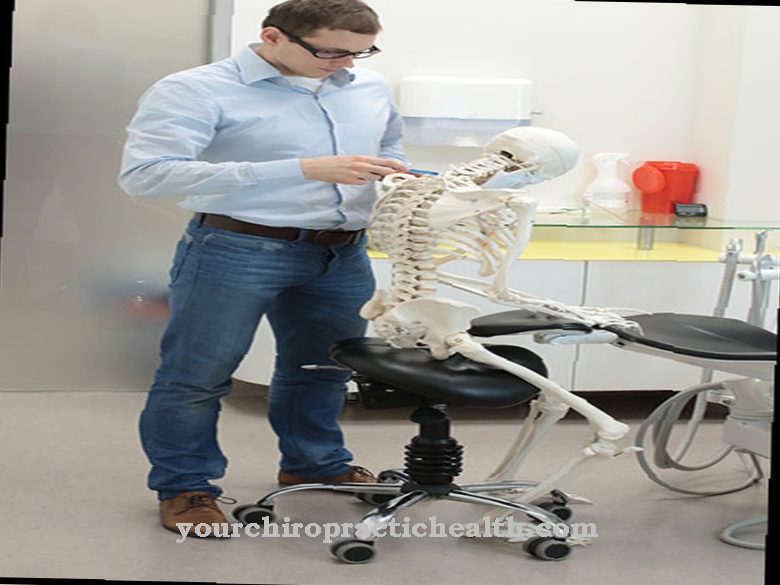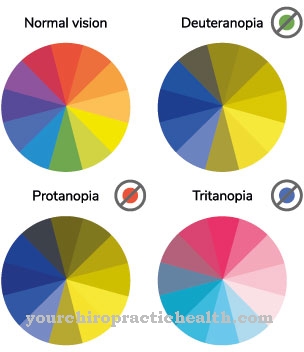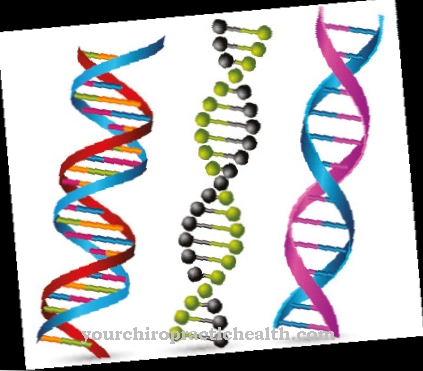SARS is the abbreviation for Severe Acute Respiratory Syndrome and means in German severe acute respiratory distress syndrome. It is an infectious disease that is triggered by viruses. SARS first appeared in China in 2002.
What is SARS?
.jpg)
© dottedyeti - stock.adobe.com
SARS (severe acute respiratory distress syndrome) is an infectious disease caused by a specific strain of virus called the coronavirus. The illness is subject to notification. The pathogen was discovered by the doctor Dr. Carlo Urbani discovered, who himself fell victim to the virus.
The disease causes severe shortness of breath and flu-like symptoms with fever, cough, hoarseness and sore throat. The symptoms appear suddenly and very severe right from the start.
SARS occurred for the first time in China in 2002, the first case in Germany became known in 2003. At that time, almost 30 countries reported cases of illness; however, the most common SARS diseases were in Thailand, China and Hong Kong.
A total of around 8,000 people were infected and fell ill, around 800 of whom died. No other case of SARS has occurred since 2003.
causes
The causes for SARS are viruses that were unknown to humans until the onset of the disease. It is the group of coronaviruses. Until now, this virus was only known from animals. It is believed that it was first transmitted to humans by a certain type of cat in China, whose meat is used as food there.
But the disease can also be passed on through living very closely with covertly infected animals. At first it was assumed that the infection among humans only takes place through the so-called droplet infection. The virus is transported via saliva, nasal secretions or other body fluids.
However, since people who had no direct contact but only lived in the same house also got sick, it was concluded that the SARS virus can also spread via the air or water. The amazing thing is that the pathogen can apparently survive a period of 24 hours even without a host.
Symptoms, ailments & signs
According to the Infection Protection Act (IfSG) Section 6, Paragraphs 5a and 5b, SARS is notifiable in the event of a suspected disease, outbreak or death due to SARS. According to the World Health Organization (WHO), the suspicion of SARS is fulfilled if a fever of over 38 ° C is detectable, the disease shows signs of pneumonia (pneumonia), meaning the following symptoms: headache, body aches, dry cough, rarely chills) and at least one respiratory symptom occurs, i.e. a disturbance of external breathing.
Previous close contact with SARS-infected people (within 10 days before the onset of symptoms), as well as a stay in regions where SARS occurs frequently, also constitutes a suspicion of Sars. If these criteria are met and an X-ray indicates an acute one Pneumonia or an acute respiratory distress syndrome or an unexplained respiratory disease resulting in death is a likely case of SARS.
SARS symptoms appear after an incubation period of two to ten days. This leads to fever, chills, headaches, fatigue, muscle pain (myalgia) and diarrhea. Older people have more severe courses, but they can also be free of fever. Fever, dry cough, hoarseness, sore throat, shortness of breath and low oxygen content in the blood (hypoxemia) are also symptomatic. The clinical picture worsens significantly (exercise) and can lead to lung failure.
Diagnosis & course
The incubation period of SARS is very short and only lasts two to seven days. The incubation period is the period between the moment of infection and the appearance of the first symptoms. The illness usually begins with a sudden high fever and a very strong feeling of illness. This is followed by flu-like symptoms such as headache and body aches, sore throat, hoarseness and cough.
Chills, diarrhea, loss of appetite and a rash can also occur. Some patients can no longer move properly because the muscles become stiff. Confusion can also occur. SARS can be both very mild and fatal.
A diagnosis of SARS is suspected if the known symptoms are present in people who have been in the specifically affected countries. In the further course of the virus infection must be confirmed by a blood test. An X-ray examination and computed tomography also contribute to the reliable establishment of the SARS diagnosis.
Complications
Severe acute respiratory syndrome symptoms may develop into severe complications. If the treatment is too late or if the sick person is already physically very weak, the immune system can no longer fight the pathogens effectively itself. As a result, there is a high fever and the resulting circulatory problems.
Prolonged diarrhea can make the person dehydrated. The lack of fluids and nutrients usually results in further complications, for example impaired consciousness, dehydration and fatigue. Difficulty breathing and shortness of breath can lead to panic attacks and, in interaction with the initial symptoms, lead to heart failure. Children, the elderly and the sick in particular are at risk of dying from the extreme physical strain.
Treatment for SARS is relatively risk-free. However, the drugs administered can cause side effects. Antibiotics and the hepatitis C drug ribavirin in particular cause symptoms such as rashes, spasms of the respiratory muscles and anemia. In combination with other preparations, further complications can occur. If the patient has to be given intravenous fluids, this can in some cases lead to injury, aspiration and allergic reactions.
When should you go to the doctor?
Anyone suffering from SARS must see a doctor as soon as possible. While the disease cannot be cured, therapy can provide relief. However, the danger of severe acute respiratory syndrome is mainly due to possible accompanying infections of a bacterial nature. These can be cured by administering antibiotics. Antibiotics are also used for prevention.
A comprehensive check of the lungs by a specialist (or in a specialized hospital) is urgently needed.In addition, SARS always carries the high risk of infection, which is why the necessary medical measures can also include quarantine.
The symptoms of severe acute respiratory distress syndrome are serious enough to cause those affected to see a doctor anyway. SARS does not necessarily have to be considered in the event of shortness of breath due to the enormous irritation in the throat. The disease is rare and few outbreak sites are known. Only people who work with the virus in laboratories are currently at risk. A differential diagnosis is also useful when typical symptoms occur. For example, it must be ruled out that it is the MERS virus.
Treatment & Therapy
So far there is no special treatment of SARS known, so therapy initially focuses on symptom relief. Success was achieved with the broad spectrum antibiotic ribavirin, which is also used to treat hepatitis C.
It is able to fight several different pathogens. Cortisone is also given to treat any bacterial infections that may occur as a result of the viral infection. In addition, a mixture of various other antibiotics is given. Patients infected by the SARS pathogen must be accommodated in an isolation ward with a lock because of the extremely high risk of infection.
For the hospital staff, protective gowns, breathing masks, protective goggles and gloves are required when treating patients. Research is now being carried out on a vaccine for SARS, but none has yet been developed. SARS last occurred in 2003. Since no new case has been known since then, it is assumed that the SARS virus no longer exists.
You can find your medication here
➔ Medication for shortness of breath and lung problemsprevention
As a prevention against SARS It was recommended to avoid large crowds, especially in China, Thailand and Hong Kong, which were badly affected by the disease at the time. Respiratory masks such as those worn by doctors during operations were also recommended. Frequent hand washing offers additional protection.
Aftercare
Medical follow-up care for severe acute respiratory syndrome is difficult because there are neither many options for targeted treatment nor extensive knowledge of the disease. The aftercare measures therefore mostly consist in protecting the SARS survivors.
The disease weakens those affected to varying degrees, which is why treatment and follow-up care vary from case to case. There were many cases of SARS sufferers in whom the symptoms were only mild. Accordingly, they recovered very quickly and no longer required medical follow-up care.
In some cases of acute respiratory syndrome, however, there are very severe symptoms that debilitate those affected. In about ten percent of all cases, the infected also die. In severe cases, a recovery phase is appropriate after healing. Lung and bronchial tissue affected by the virus and subsequent bacterial infections need some time to regenerate. People who have had SARS should therefore avoid overexertion and polluted air for some time.
It is also possible that the corona virus, which causes SARS, also attacks the spleen, nerves and spine. A corresponding follow-up examination can be useful for SARS patients who also have other symptoms besides breathing and lung problems.
You can do that yourself
The severe acute respiratory distress syndrome is a highly contagious disease. Therefore, if an infection becomes known in the social environment, sufficient protective measures should be taken to secure against any transmission. The syndrome must be reported if there is a known infection. This is why it is extremely important to work with a doctor in the event of the first irregularities and health problems.
Since the symptoms include an increased body temperature, a sufficient amount of fluid must be consumed. If the fever persists, the body threatens to dry out. Since dehydration can become a life-threatening condition, several liters of water should be consumed daily. The disease is a great burden for the patient and the social environment. It is therefore particularly important to remain calm. Panic is to be avoided at all costs. The person's sleep hygiene should be checked and optimized.
Stress and hectic rush are to be kept away from the sick person. The organism needs all strength and energy for the healing process. For this reason, disruptive factors and situations of emotional stress must be reduced to a minimum. The symptoms of the disorder can easily be mistaken for flu. However, since it can be fatal, a diagnosis should be obtained from a doctor as soon as possible. Spontaneous healing or recovery based on alternative healing methods is not to be expected.

.jpg)

























